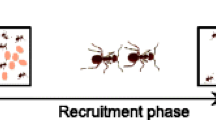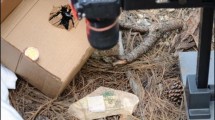Abstract
Division of labour during colony emigration is widespread in ants. An important problem is how tasks are allocated during colony movement from one nest site to another. The generally favoured view is that emigrations are organised by a minority group of individuals, which either work unusually hard at tasks (“elites”) or have the exclusive task of carrying out the emigration (moving specialists). Five consecutive emigrations of a Leptothorax unifasciatus (Latr.) colony showed that the number of transporters, i.e. the individuals that took an active part in the emigration by transporting brood and ants, was smaller than it would have been if allocation of this task was random during each emigration. However, single emigrations of another three colonies, for which the spatial distribution and behaviour of the workers had been observed for a week prior to the emigration, demonstrated that the transporters did not form a homogeneous group. They differed in their spatial positions and tasks before the emigration. There was also no evidence that transporters worked harder or less hard than their nestmates before the emigration. Therefore, the individuals which carry out emigrations in L. unifasciatus colonies appear to be neither moving specialists nor “elites”. We propose that task allocation during emigrations of L. unifasciatus colonies is based on a feedback mechanism that involves learning.
Similar content being viewed by others
References
Abraham M, Pasteels J (1980) Social behaviour during nest-moving in the ant Myrmica rubra (L.) (Hymenoptera, Formicidae). Insectes Soc 27:127–147
Becker RA, Chambers JM, Wilks AR (1988) The new S language: a programming environment for data analysis and graphics. Wadsworth and Brooks/Cole, Pacific Grove, California
Deneubourg J-L, Goss S, Pasteels JM, Fresneau D, Lachaud J-P (1987) Self-organization mechanisms in ant societies (II). Learning in foraging and division of labor. In: Pasteels JM, Deneubourg J-L (eds) From individual to collective behavior in social insects (Experientia supplement 54). Birkhäuser, Basel, pp 177–196
Dobrzanska J (1973) Ethological studies on polycalic colonies of the ants Formica exsecta (Nyl.). Acta Neurobiol Exp 33: 597–622
Franks NR (1985) Reproduction, foraging efficiency and worker polymorphism in army ants. In: Hölldobler B, Lindauer M (eds) Experimental behavioral ecology and sociobiology (Fortschritte der Zoologie 31). Sinauer, Sunderland, pp 91–107
Franks NR, Sendova-Franks AB (1992) Brood sorting by ants: distributing the workload over the work-surface. Behav Ecol Sociobiol 30:109–123
Franks NR, Tofts CMN (1994) Foraging for work: how tasks allocate workers. Anim Behav 48:470–472
Hölldobler B, Wilson EO (1990) The ants. Belknap, Cambridge
Kneitz G (1964) Untersuchungen zum Aufbau und zur Erhaltung des Nestwärmehaushaltes bei Formica polyctena Foerst. (Hymenoptera: Formicidae). Doctoral dissertation, Bayerische Julius-Maximilianus-Universität, Würzburg
Lane AP (1977a) Recrutement et orientation chez la fourmi Leptothorax unifasciatus (Latr.). Rôle de la piste et des tandems. Thèse de doctorat, Université de Dijon
Lane AP (1977b) Tandem-running in Leptothorax unifasciatus (Formicidae, Myrmicinae): new data concerning recruitment and orientation in this species. Proceedings of VIII International Congress of IUSSI, Wageningen, pp 65–66
Manly BFJ (1991) Randomization and Monte Carlo methods in biology. Chapman and Hall, London
Meudec M (1977) Le comportement de transport de couvain lors d'une perturbation du nid chez Tapinoma erraticum (Dolichoderinae). Rôle de l'individu. Insectes Soc 24:345–352
Meudec M, Lenoir A (1982) Social responses to variation in food supply and nest suitability in ants Tapinoma erraticum. Anim Behav 30:284–292
Möglich M, Hölldobler B (1974) Social carrying behavior and division of labour during nest moving in ants. Psyche 81:219–236
Möglich M, Hölldobler B (1975) Communication and orientation during foraging and emigration in the ant Formica fusca. J Comp Physiol A 101:275–288
Rohlf FJ, Sokal RR (1981) Statistical tables, 2nd edn. Freeman, New York
Schneirla TC (1953) Modifiability in insect behavior. In: Roeder KD (ed) Insect physiology. Wiley, New York, pp 723–747
Sendova-Franks AB, Franks NR (1993) Task allocation in ant colonies within variable environments (a study of temporal polyethism: experimental). Bull Math Biol 55:75–96
Sendova-Franks AB, Franks NR (1994) Social resilience in individual worker ants and its role in division of labour. Proc R Soc Lond B 256:305–309
Sendova-Franks AB, Franks NR (1995) Spatial relationships within nests of the ant Leptothorax unifasciatus (Latr.) and their implications for the division of labour. Anim Behav (in press)
Sokal RR, Rohlf FJ (1981) Biometry, 2nd edn. Freeman, New York
Theraulaz G, Goss S, Gervet J, Deneubourg J-L (1990) Task differentiation in Polistes wasp colonies: a model for self-organizing groups of robots. In: Mayer JA, Wilson S (eds) Simulation of animal behavior: from animals to animats. MIT Press, Cambridge, pp 346–355
Tofts C (1993) Algorithms for task allocation in ants. (A study of temporal polyethism: theory). Bull Math Biol 55:891–918
Tofts C, Franks NR (1992) Doing the right thing: ants, honeybees and naked mole-rats. Trends Ecol Evol 7:346–349
Topoff HR, Mirenda J (1980) Army ants on the move: relation between food supply and emigration frequency. Science 207: 1099–1100
Topoff HR, LaMon B, Goodloe L, Goldstein M (1984) Social and orientation behavior of Polyergus breviceps during slave-making raids. Behav Ecol Sociobiol 15:273–279
Wilson EO (1971) The insect societies. Belknap, Cambridge
Wilson EO (1980) Caste and division of labor in leaf-cutter ants (Hymenoptera: Formicidae: Atta), I: The overall pattern in A. sexdens. Behav Ecol Sociobiol 7:143–156
Author information
Authors and Affiliations
Additional information
Communicated by R.F.A. Moritz
Rights and permissions
About this article
Cite this article
Sendova-Franks, A.B., Franks, N.R. Division of labour in a crisis: task allocation during colony emigration in the ant Leptothorax unifasciatus (Latr.). Behav Ecol Sociobiol 36, 269–282 (1995). https://doi.org/10.1007/BF00165836
Received:
Accepted:
Issue Date:
DOI: https://doi.org/10.1007/BF00165836




